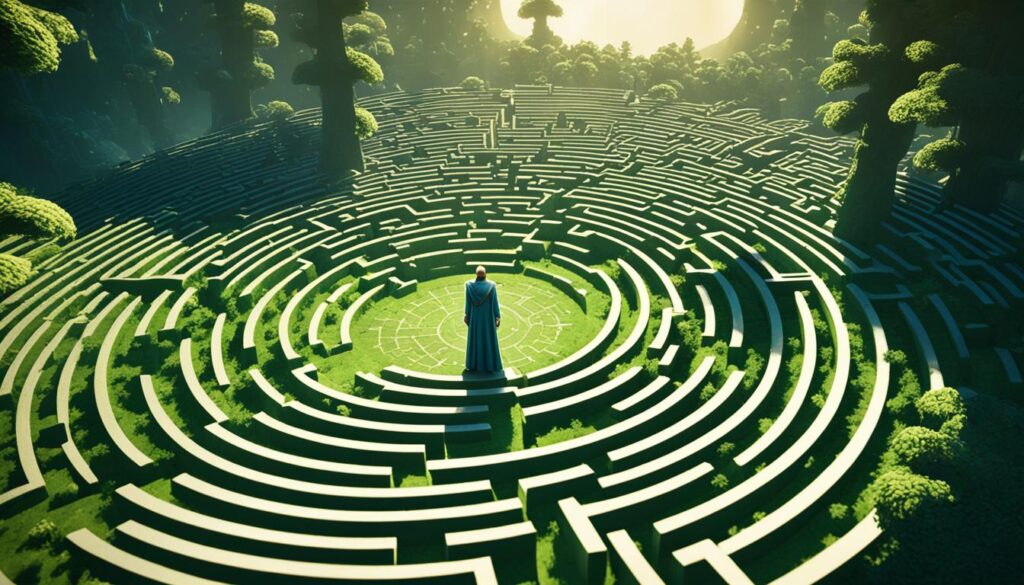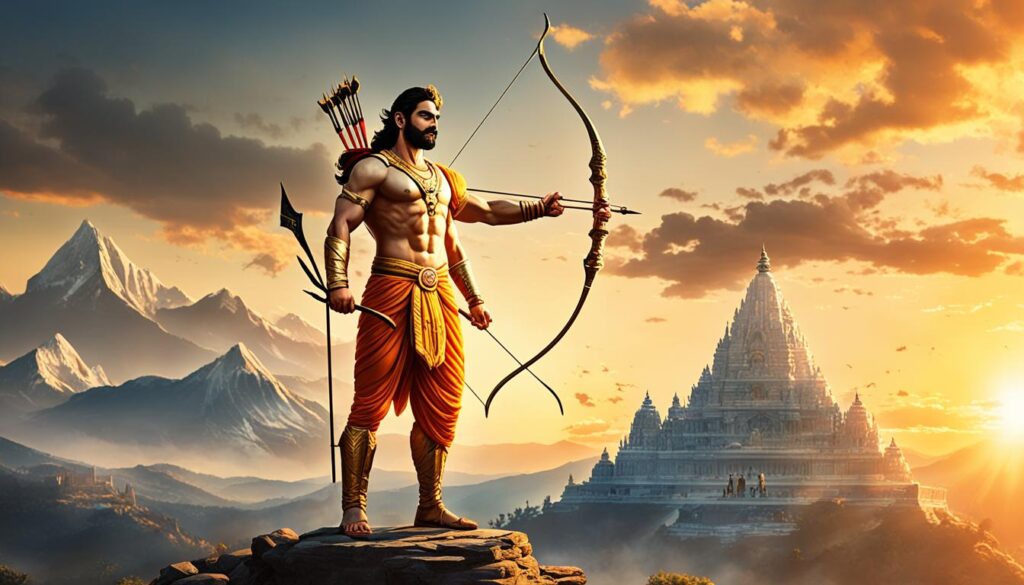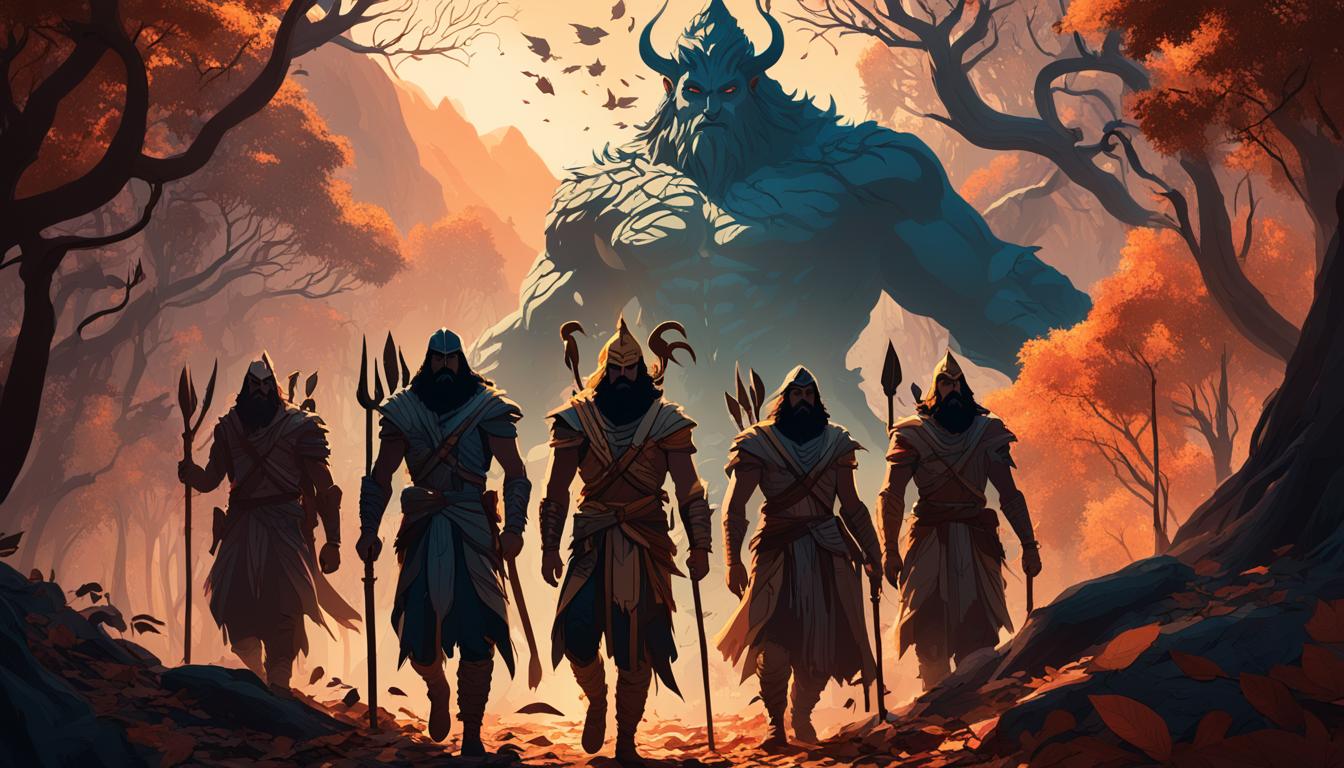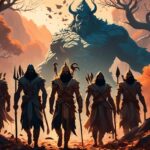Have you ever wondered why the Ramayana, an ancient Hindu epic, keeps people amazed for generations? It’s because the story mixes spiritual, cultural, and historical parts of India together. This makes it more than just a myth; it’s like a living history for many.1 So, what makes this tale so special, and how can we learn from it?
The Ramayana follows the adventures of Lord Rama and his wife, Sita, with his brother, Lakshmana, and the great Hanuman.1 From the beautiful Ayodhya to the tough battles in Lanka, this story has held hearts and minds for ages. It’s proof of the power of words passed down and the draw of old stories.1
By understanding the Ramayana‘s history, myths, and spiritual ideas, we find deep lessons and truths that still matter today. It’s an exciting look into ancient wisdom.1 Let’s explore this incredible epic, revealing its timeless secrets. These insights can guide us on our life’s journey.
Key Takeaways
- The Ramayana is an ancient Hindu epic that spans over 3,000 years of history.1
- The epic’s journey from generation to generation, whispered from mouth to mouth, is a testament to the power of oral tradition.1
- Unraveling the Ramayana‘s layers reveals profound insights and universal truths that still resonate with modern audiences.1
- The Ramayana weaves together the spiritual, cultural, and historical fabric of India, making it a captivating exploration of ancient wisdom.1
- Customized travel itineraries allow visitors to trace the footsteps of the deities and connect with the past that continues to live on.1
The Timeless Tale of Ramayan
The Ramayan is a story attributed to the sage Valmiki. He is known as the first poet in the Sanskrit language. Valmiki’s epic tale tells of Lord Rama. Rama is a symbol of goodness and what is right.
This story begins with Rama’s birth into a royal family in Ayodhya. It goes on to tell about his time in the forest. It also includes the sad event of his wife Sita being taken. The story ends with a big fight against Ravana, a demon king.2
Valmiki’s Epic Masterpiece
The Ramayan’s creation is credited to the sage Valmiki. He is often regarded as the first Sanskrit poet. The Valmiki Ramayana, written in Sanskrit, is seen as the main version of the story.2 Valmiki’s work tells of Lord Rama. Rama is a model of goodness and justice.2
Lord Rama: The Embodiment of Virtue
It talks about Rama’s life, from being a prince to facing challenges. He had to leave his kingdom and go to the forest. This happened with his wife Sita being taken. Finally, there was a great battle with Ravana.2
Rama’s story teaches us about duty, love, and loyalty. It discusses the age-old fight between right and wrong. This makes the Ramayan a story that never gets old.2
The Journey from Prince to King
The epic tells the story of Rama from his birth. Rama became king, but then he had to leave his kingdom. He went to the forest and faced a tough challenge when Sita was taken. This led to a big fight with Ravana.2
Its main draw is how it captures the hearts of people from all times. It shows the power of a well-told story. And it highlights the lasting impact of Lord Rama‘s tale.2
Ayodhya: The Cradle of Civilization
Ayodhya is more than just a place on the map. It’s seen as a perfect land known as Ram Rajya. This means a place where everything is fair, just, and everyone lives in peace.3 It’s the heart of the Ramayan, the great Indian epic, where the story begins.4 People visit to see the holy spots and old temples. They come to feel close to Lord Rama and learn from his stories.3 Its story lives on, showing the lasting power of the Ramayan story and Lord Rama’s teachings.
The Birthplace of Lord Rama
At its peak, Ayodhya was about 250 km² large. It’s known as one of Hinduism’s holiest cities, written in texts like the Brahmanda Purana.3 The city was ruled by the Ikshvakus, part of a royal line. Their rule goes back to Ikshvaku, the son of Vaivasvata Manu.3 Some experts say Ayodhya, in a certain text, means “unconquerable.”3 It’s also where five Tirthankars, with the first one being Shri Rishabh Dev of Jainism, were born.3
Tracing the Footsteps of the Divine
Ayodhya has faced invasions over the centuries, losing temples and special places.4 But, Hindu leaders have always tried to repair and rebuild these sacred sites. There is proof of this from archaeology.4 The dispute over the Ramjanmabhumi temple started when it was ruined. Since then, Hindus have worked to recover this holy place.4 Ayodhya was at its best under the Guptas and was later part of the Mughal Empire. Then it came under British rule from 1856.3
Many see Ayodhya as a holy city where one can find spiritual peace, like Varanasi and Dwarka.3 Most of the people living here are Hindu, with some Muslims, Jains, and Buddhists too.3 The place pointed out as Lord Rama’s birth spot has both a mosque, built in 1528 by Babur, and ruins of an old temple underneath.3
The Abduction of Sita
The Cunning Plot of Ravana
The Ramayan story tells us about how Ravana kidnapped Sita, Rama’s wife.5 Ravana was no ordinary demon; he had ten heads and twenty arms. He boasted about his great power, like being able to lift the earth and drink from the ocean. His plan was to lead Sita away, causing a big battle.
The Search for the Lost Princess
Rama and his friends set out to save Sita after her abduction.5 Ravana took her against her will, and she cried for Rama to save her.5 She also reached out to Lakshmana and called upon the forest gods for help.
Her abduction tested the heroism of Rama.6 Hanuman tried to rescue Sita, but she wanted only Rama. This shows her deep love and trust in her husband.6 The tale of Hanuman’s struggles in getting to Lanka teaches us about persistence in seeking the divine.
The Vaanara Sena: Rama’s Faithful Allies
The Vaanara Sena was a key part of Rama’s journey to rescue Sita. This mighty monkey army stood by the prince firmly.7 Some say the Vanaras were part-divine, with special powers. They were born from or took the form of gods to help Rama.7
In art, they’re often shown as ape-like beings. Yet, their true nature, which might include shapeshifting, remains a mystery.7 During Rama’s search for Sita and the fight against Ravana, these Vanaras proved themselves loyal, brave, and caring.7
Hanuman: The Embodiment of Devotion
Hanuman shines in the Vaanara Sena, known for his deep devotion, bravery, and loyalty.7 He could change form, showing his incredible skills. This makes him a standout figure in the Ramayana.78 Hanuman appears not just in the Ramayana but also in the Mahabharata. He’s considered an immortal for his exceptional qualities.8
His unmatched strength and his loyal service to Rama have made Hanuman a beloved character in this classic tale.7 His well-known leap and perpetual faith in Rama have made him legendary.
The Mighty Monkey Army
The Vaanara Sena played a big role in the battle against Ravana. Their story teaches about the power of coming together and overcoming evil.7
Key members of this Sena include Hanuman, Angada, Sugriva, Vali, and more. They all had important parts to play in Rama’s story.7 The Vanaras are remembered for their part in building a bridge and assisting Rama. This underlines their crucial role in the mission.7
The Epic Battle of Lanka
The Ramayan’s most thrilling moment comes in the battle of9 Lanka. Here, Rama fights with his friends against demon king Ravana and his huge army. This fight between good and evil is at the core of the Ramayan, showing Rama’s goodness against Ravana’s power.10
The Clash of Good and Evil
This battle shows Rama’s incredible courage and the hard work of his friends. They aim to save Sita and bring peace back. With nearly 24,000 verses,9 the Ramayana is split into seven parts, which are called kandas.9
Rama’s Triumph Over Ravana
Rama’s victory over Ravana highlights his skill as a warrior. It also shows how good (dharma) always wins over evil (adharma).9 The Ramayana probably started between the 7th and 4th centuries BCE. Its late parts might be up to the 3rd century CE.9
The story of the Ramayana has spread to many places like Cambodia, Indonesia, the Philippines, and more.9 It teaches the value of being good in personal and community life.9
Ramayan: A Living Legacy

More than just an old epic, the11 Ramayan is a living tradition. It enchants and uplifts people even today. Its story has been kept alive through speech, handed down from one speaker to the next. This shows the deep impact of the Ramayan.
The Ramayan is not just a story. It mirrors Indian life and values. In India, many families read or recite the Ramayan for its teachings. Thus, the epic stays fresh and meaningful over time.
Preserving Oral Traditions
The Ramayan’s tale has inspired much art. It has moved people in many countries, despite being ancient. The story of Rama, which lies at its heart, has touched various cultures. This is a clear sign of the Ramayana’s broad influence on Hindu beliefs and traditions.
Temples and Sacred Sites
The story of the Ramayana has reached far beyond India. Places like Thailand, Indonesia, and Japan cherish its lessons too. Also, in India, you can find many temples and sites dedicated to the Ramayan. They welcome all to learn from its enduring wisdom and to feel closer to the divine.
Unraveling Ancient Wisdom
The Ramayan isn’t just a thrilling story of bravery and adventure; it holds ancient wisdom too. It teaches us important lessons about living a good life. These lessons are shown through Rama’s journey. They stress on doing what is right and keeping promises, even when things are tough.12
Dharma: The Path of Righteousness
The Ramayan talks a lot about dharma, which is the right way to live. It shows us how choosing good over evil can result in a better life. The characters show us the rewards of doing what’s right and the cost of wrong actions.12 This shows the ongoing importance of the Ramayan’s teachings in our lives today.
The Pursuit of Self-Realization
The Ramayan also touches on knowing oneself better. It shows us a path to understand the divine and our souls.13 It leads readers to think about who we are and our connection to the universe. By doing so, it helps us find deeper meaning in life.
Ramayan’s Relevance Today

In today’s ever-changing world, the lessons from the Ramayan are still very important.14 It talks about things like doing what’s right, staying faithful, and the fight between good and bad. These ideas still touch our hearts, offering lessons for life today.14
Timeless Lessons for Modern Times
The Ramayan helps connect the old with the new. It lets us see ancient wisdom in a way that matters today.14 This story is more than an ancient tale; it challenges us to think about our values and the world we want to live in. It’s a key to growing as a person and changing society.14
Bridging the Past and Present
Why does the Ramayan still touch our lives today? It’s more than just a story; it links yesterday with today.14 Through its timeless teachings, we get a better understanding of being human. This can help improve our lives now.14
Tracing the Ramayan Trail
If you love the15 Ramayan’s story and heritage, following Lord Rama’s path can change your life. Experts have planned a journey through the places deeply connected to the epic.15
The Ramayana Trail Itinerary
You can start your adventure at Rama’s birthplace, Ayodhya15. Then, see the famous warfields in Lanka. This trail lets you dive into the Ramayan’s heart, seeing its ancient wonders.15 Places like Guntur and Vizianagaram in Andhra Pradesh are on the list. There’s also Murkongselek, Ambassa, and Silchar. Don’t forget Bhagalpur and Muzaffarpur in Bihar. It’s a journey through legends.16
Experiencing the Epic Journey
Walking the Ramayana Trail is more than sightseeing. It’s about feeling the epic journey deep in your soul. This story has touched many states like Madhya Pradesh and Tamil Nadu. It’s a journey through legends.16
Key spots in the Ramayan story include places like Jammu and Kashmir. There, the influence of Ramayana is strong. Cities like Silchar celebrate through art.16 Indian Railways also plans to celebrate, making all stations bright for Lord Ram’s temple event.16
Preserving Cultural Heritage
The Ramayan’s legacy shows the strength of storytelling. It also highlights the need to protect cultural heritage. This epic story is like a shared memory, blending history, myth, and spiritual beliefs. It deeply influences the values and identity of the Indian subcontinent.17
The Importance of Storytelling
We, the present generation, must keep the Ramayan alive. We should share its timeless wisdom through our storytelling. It’s our duty to ensure its important teachings endure.18
Passing the Torch to Future Generations
Passing the Ramayan to future generations is crucial. It means the lessons and respect for Lord Rama stay in our culture. They will continue to guide people for many, many years.19
| Statistic | Data |
|---|---|
| Exhibition Duration | The cultural exhibition ‘Chitrakavyam Ramayanam’ lasted two months at the National Gallery of Modern Art in Delhi.17 |
| India’s Share of Sri Lankan Tourism | India constitutes 20% of the largest source market for tourists to Sri Lanka.17 |
| Free Visa Regime in Sri Lanka | Sri Lanka implemented a free visa regime to India and other countries until March 31, 2024.17 |
| Ramayana Exhibition Duration | Exhibition “Ramayanam Chitra Kavyam” will be on view till 30th April 2024.18 |
| Exhibition Visitor Count | Visitor counter for the release is at 895.18 |
| Ramayana Short Films Produced | 17 short films have been produced under the Ramayana Project of the ICH Division.19 |
Conclusion
The Ramayan takes us on a thrilling journey through ancient wisdom. It is a timeless story about spirituality, culture, and history in India. Created by the sage Valmiki, this tale goes beyond myth. It speaks to people of all ages.20
This story shows us essential truths about being human. It helps us understand life better. The Ramayan is more than a story. It’s a guide for our own life journeys.21
In the Ramayan, we find wisdom that never ages. It links our past with our present. This link is important. It shows us where we came from and where we can go.22
We learn a lot from this ancient tale. By keeping its teachings alive, we keep the spirit of the epic alive, too. This helps us now and in the future. It’s a way to stay connected to wise lessons from the past.
FAQ
What is the Ramayan?
The Ramayan tells the story of Lord Rama, the seventh form of Lord Vishnu. Valmiki, a sage, wrote this epic. It combines history, culture, and spirituality in India.
Who is Valmiki, the author of the Ramayan?
Valmiki wrote the Ramayan. He is the first known poet in Sanskrit. The Ramayan highlights Lord Rama’s noble character and his life’s adventures.
What is the significance of Ayodhya in the Ramayan?
Ayodhya is not only Lord Rama’s birthplace but also a symbol of an ideal society called Ram Rajya. It stands for justice, harmony, and fairness. In the Ramayan, it is the vital setting for the story.
What is the significance of the abduction of Sita in the Ramayan?
When Sita, Rama’s wife, is kidnapped by Ravana, the story’s key events start. Rama and his friends, like strong Hanuman, journey to save her. This highlights loyalty and bravery.
Who is Hanuman, and what is his role in the Ramayan?
Hanuman is a member of the Vaanara Sena known for his unwavering loyalty and bravery. His acts of leaping across lands and support for Rama are legendary.
What is the significance of the epic battle of Lanka in the Ramayan?
In the battle of Lanka, Rama faces Ravana, the demon king, in an ultimate showdown. This represents the struggle between good and evil at the Ramayan’s core.
How does the Ramayan continue to be relevant today?
The story’s themes of duty, loyalty, and the battle between good and evil still connect with people today. It teaches lessons that help understand and navigate life.
What is the Ramayana Trail, and why is it a transformative experience?
The Ramayana Trail guides people through sites and landmarks crucial to the epic. Walking this trail allows visitors to deeply connect with the narrative. It offers a profound journey experience.
Why is it important to preserve the cultural heritage of the Ramayan?
Preserving the Ramayan’s cultural significance is crucial for future generations. It ensures its profound teachings and respect for Lord Rama’s legacy continue to inspire for years to come.
Source Links
- https://travebrate.medium.com/reliving-the-epic-tracing-lord-ramas-footsteps-across-millennia-bd3e10eda289?source=rss——travel-5
- https://prabhukedwar.in/ramayana-the-epic-tale-of-heroism-and-devotion
- https://pparihar.com/2023/02/28/ayodhya-and-ram-in-atharved/
- http://prashanth-vaidyaraj.blogspot.com/2020/04/ram-ayodhya-by-meenakshi-jain-journey.html
- https://www.wisdomlib.org/hinduism/book/the-ramayana-of-valmiki/d/doc424146.html
- https://library.acropolis.org/tales-from-the-ramayana-the-abduction-of-sita
- https://en.wikipedia.org/wiki/Vanara
- https://www.artisanscrest.in/blogs/artisan-of-the-month/hanuman-the-loyal
- https://en.wikipedia.org/wiki/Ramayana
- https://asianartnewspaper.com/the-ramayana-and-sri-lanka/
- https://medium.com/@exoticindiaa/how-to-understand-the-historical-landmarks-similarities-and-dissimilarities-of-ramayana-70df0ba15bf9
- https://www.linkedin.com/pulse/unraveling-timeless-wisdom-teaching-values-ramayana
- https://medium.com/@my.untold.stories/unraveling-the-scientific-wisdom-of-ancient-india-insights-from-vedas-and-puranas-da615f820bab
- https://feminisminindia.com/2020/04/10/revisiting-ramayana-relevance-feminist-lens/
- https://timesofindia.indiatimes.com/travel/destinations/ramayana-trail-retracing-the-journey-of-rama-and-sita/photostory/86758901.cms
- https://www.aninews.in/news/national/general-news/tracing-the-ramayana-trail-indias-railway-stations-echo-epics-cultural-impact20240117193119
- https://timesofindia.indiatimes.com/india/ramayana-a-common-cultural-narrative-for-india-sri-lanka-says-lankan-minister-jeevan-thondaman/articleshow/108154912.cms
- https://www.pib.gov.in/PressReleasePage.aspx?PRID=2010820
- http://intangibleheritage.intach.org/the-ramayana-project-vignettes-of-ramayana/
- https://www.classace.io/answers/write-an-essay-about-the-ramayana
- https://www.britannica.com/topic/Ramayana-Indian-epic
- http://vgulla.blogspot.com/2011/03/conclusions-and-conundrums-with.html

